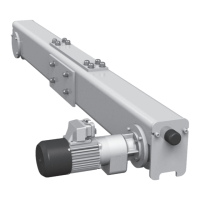4
SINGLE & DOUBLE GIRDER TOP-RUNNING BRIDGES
WITH INDIVIDUAL MOTOR DRIVEN
END TRUCKS
P/N: 11532620 REV. AA September 2018
panel, bridge panel to cross conductors, bridge panel to bridge.
motor) in accordance with the appropriate crane interconnection
wiring diagram as shown in Figure 10. If bridge motors quick
connection plugs are not pre-wired, connect leads on motor cables
from the bridge control panel per Figure 1.
Figure 1. Bridge Gear Motor Quick Connection Plug
CAUTION
Gearmotors provided with this crane kit are intended for
variable frequency control only. The brake used on the
gearmotor is a holding brake with no provision for torque
adjustment. Severe load swing will result without the
controlled deceleration when stopping provided by the
variable frequency control. The use of contactor, across the
line starting, controls is not permitted, will result in damage
and premature failure of these units and void any warranty.
NOTICE
Prior to placing the crane into service, the crane shall
receive an initial inspection. This inspection should be
performed by a qualied person in accordance with
ANSI/ASME B30.2 or B30.17, local, state and provincial
standards and regulations.
START-UP AND PRE-OPERATIONAL INSPECTION
After the crane has been installed on the runway and the crane,
hoist and trolley has been connected to electrical service but prior to
placing into service, as a minimum the following inspections should
be made by a qualied person.
1. Check the main collector system for proper adjustment to
maintain proper contact with conductors. Check along runway
for possible interference if power is supplied by a cable reel or
festooned cable.
WARNING
Lock main runway disconnect switch in open position
before attempting to adjust main collectors or conductors.
2. Check the cross and pushbutton festoon conductors for
adjustment, including cable loop depth, and tracking.
3. Check oil level in both drive gearcases and axle bearing grease
ttings (if provided) for proper lubrication. If lubrication is required
refer to the LUBRICATION SECTION of this manual.
4. Inspect crane to make certain that all bolted connections
and attachments are properly tightened and that all electrical
connections are secure.
5. Inspect and adjust the motor brake air gap. Refer to the
MAINTENANCE SECTION of this manual.
6. The hoist/trolley should be inspected as instructed in the hoist/
trolley manufacturers instruction manual. For a single girder crane
inspect the clearance between the trolley wheels and toe of ange
on bridge girder beam per manufacturers requirements. For a double
girder crane inspect the clearance between wheel anges and the
girder rail per manufacturers requirements. If hoist is equipped with
adjustable limit switches, conrm settings meet the applications
requirements.
7. Inspect the alignment of the trolley end stops to the trolley and the
runway end stops to the bridge endtrucks.
8. Turn power on at both disconnects and mainline. Inspect hoist
for reverse phase condition by ensuring push button operation
corresponds to intended direction of travel and correct if necessary
per manufacturer’s instructions.
9. Operate the crane to verify both motors operate in the same
direction, in both bridge directions.
10. With no load operate hoist/trolley back and forth the full length
of bridge girder and operate the crane the full length of the runway.
During the operation ensure and verify proper clearances from
obstructions per CMAA, ASME B30.2, ASME B30.17 and OSHA
requirements.
11. Load testing the crane should be performed in accordance with
ANSI/ASME B30.2 or B30.17, local, state and/or provincial codes
and regulations. A written report should be prepared during the
performance of this test and placed on le.
OPERATION
OPERATOR QUALIFICATIONS
Safe and efcient crane operation requires skill, extreme care, good
judgment, alertness, concentration and knowledge of and rigid
adherence to proven safety rules and practices. No person should
be permitted to operate a crane or hoist:
1. who does not possess the above characteristics.
2. who is not qualied or has handicaps that could adversely affect
such operation.
3. who has not been properly instructed.
4. who has not been informed and does not have a thorough
knowledge of all applicable safe operating practices, including those
in this book as well as of rigging equipment and practices.
NOTICE
See applicable National, State and Local Safety Codes
and regulations for additional requirements relating to Safe
Operating Practices, including ANSI B30.2 or ANSI B30.17
- latest edition
OPERATING RULES
Operating rules listed below are an earnest effort to encourage
SAFETY and are not intended to take precedence over individual
plant safety rules and regulations or rules set forth by various
applicable codes.
A good operator operates his crane as smoothly as possible and
knows and follows the suggested rules below for safe, efcient
crane handling.
INSTALLATION CONTINUED
CMK_12322 Yale Rotating Axle End Truck Parts 11532619-REV AD_mec.indd 4 10/16/18 2:07 PM

